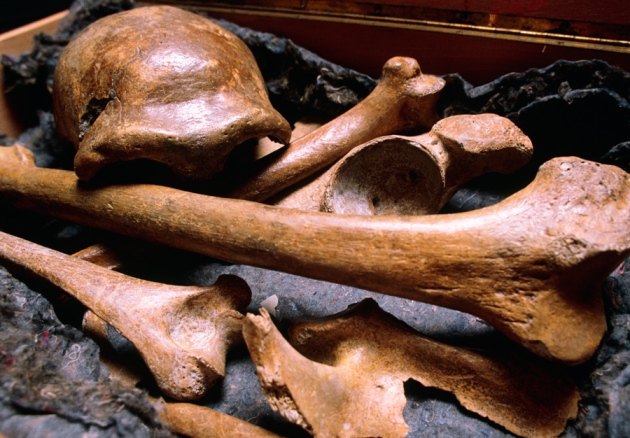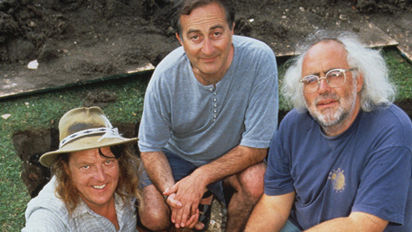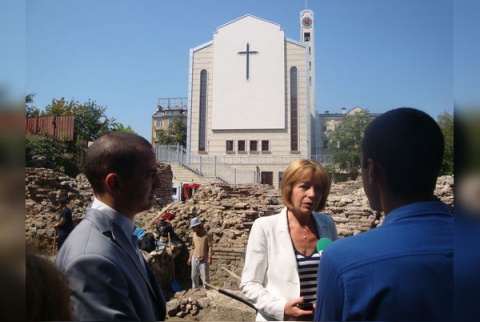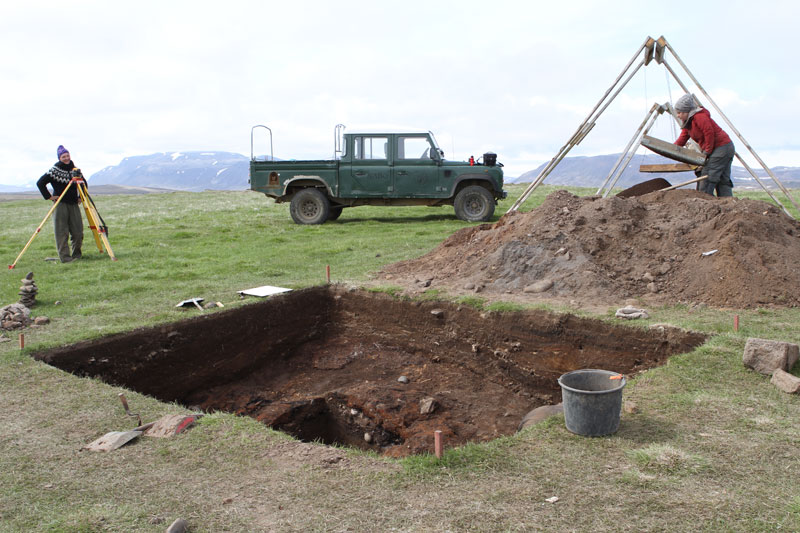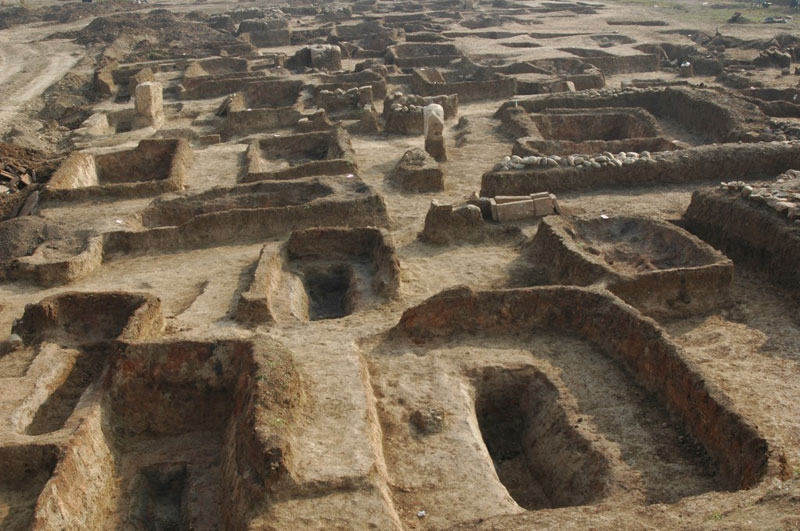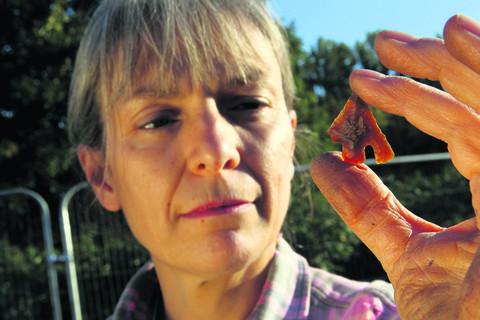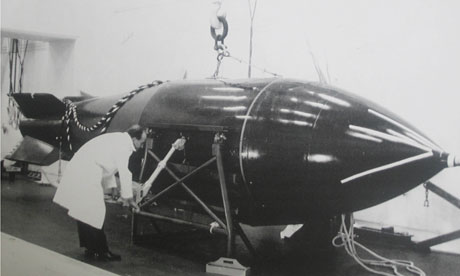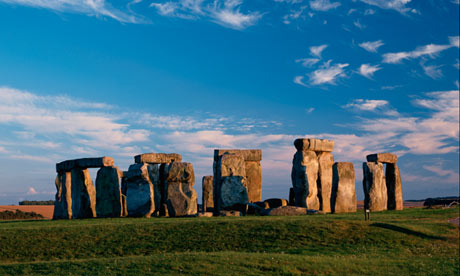Friday, October 26, 2012
Viking skeleton found in Wales
A skeleton of a Viking has been discovered by archaeologists at Llanbedrgoch, Anglesey. Scientists from Amgueddfa Cymru – National Museum Wales, who made the discovery believe it will shed new light on the interaction between Celtic, Anglo-Saxon and Viking-age worlds operating around the Irish Sea.
The skeleton find is an unexpected addition to a group of five (two adolescents, two adult males and one woman) discovered in 1998-99. Originally thought to be victims of Viking raiding, which began in the 850s, this interpretation is now being revised. Tests by Dr Katie Hemer of Sheffield University indicates that the males were not local to Anglesey, but may have spent their early years (at least up to the age of seven) in North West Scotland or Scandinavia.
The Llanbedrgoch site was discovered in 1994 after a number of metal detector finds had been brought to the museum for identification. These included an Anglo-Saxon penny of Cynethryth (struck AD 787-792), a penny of Wulfred of Canterbury (struck about AD 810), and three lead weights of Viking type.
Read the rest of this article...
Monday, October 22, 2012
Digging up the dead: London's ghoulish legacy
The Anatomist Overtaken by the Watch by William Austin, 1773 (Image: Museum of London)
It is a tale of macabre fascination and ghoulish enterprise: the rampant and horrific practice in early 19th-century London of snatching dead bodies from fresh graves - or in some cases, committing murder - to use the corpses for anatomical dissection. Nearly two centuries later, these stories still serve as a reminder of the tension between medical need and bodily autonomy.
Now an exhibition at the Museum of London adds new archaeological evidence to our understanding of the “resurrection men”, the anatomists they supplied and the occasionally blurry distinction between the two. By balancing this evidence with a careful examination of the social atmosphere, growing field of surgery and grimly simple equation of supply and demand, Doctors, Dissection and Resurrection Men offers fresh insight into a discomfiting legacy.
“Whatever we may think of what happened at the time, there is that question: was it for the greater good?” asks Jelena Beklevac, curator of human osteology at the museum.
Read the rest of this article...
Evidence of Viking Outpost Found in Canada
Archaeologist Patricia Sutherland (orange jacket) excavates a potential Viking site on
Baffin Island.
For the past 50 years—since the discovery of a thousand-year-old Viking way station in Newfoundland—archaeologists and amateur historians have combed North America's east coast searching for traces of Viking visitors.
It has been a long, fruitless quest, littered with bizarre claims and embarrassing failures. But at a conference in Canada earlier this month, archaeologist Patricia Sutherland announced new evidence that points strongly to the discovery of the second Viking outpost ever discovered in the Americas.
(Read the new National Geographic magazine feature "Vikings and Native Americans: Face-to-Face.")
While digging in the ruins of a centuries-old building on Baffin Island (map), far above the Arctic Circle, a team led by Sutherland, adjunct professor of archaeology at Memorial University in Newfoundland and a research fellow at the University of Aberdeen in Scotland, found some very intriguing whetstones. Wear grooves in the blade-sharpening tools bear traces of copper alloys such as bronze—materials known to have been made by Viking metalsmiths but unknown among the Arctic's native inhabitants.
Read the rest of this article...
Breakthrough in world's oldest undeciphered writing
Experts working on proto-Elamite hope they are on the point of 'a breakthrough'
The world's oldest
undeciphered writing system, which has so far defied attempts to uncover
its 5,000-year-old secrets, could be about to be decoded by Oxford
University academics.
"I think we are finally on the point of making a breakthrough," says Jacob Dahl, fellow of Wolfson College, Oxford and director of the Ancient World Research Cluster.
Dr Dahl's secret weapon is being able to see this writing more clearly than ever before.
Read the rest of this article...
Tomb raiders lead to new archaeological find
Votive offerings to Juno from 4th to 2nd century BC
Rome, October 19 - Investigations into the activities of four tomb raiders in the Alban hills near Rome have led to the discovery of a previously unknown site containing ancient Roman votive offerings. The ex-votos date from the fourth to the second century BC and include life-sized statues and depictions of parts of the human anatomy in terracotta offered to the ancient Roman goddess Juno. Police caught the tomb robbers in action as they were stealing the devotional objects from a natural cavity in a tufa wall near Lanuvio and Genzano that did not appear on archaeological maps of the area.Read the rest of this article...
Core sample sends carbon clock farther back in time
The carbon clock is getting reset. Climate records from a Japanese lake are set to improve the accuracy of the dating technique, which could help to shed light on archaeological mysteries such as why Neanderthals became extinct.
Carbon dating is used to work out the age of organic material — in effect, any living thing. The technique hinges on carbon-14, a radioactive isotope of the element that, unlike other more stable forms of carbon, decays away at a steady rate. Organisms capture a certain amount of carbon-14 from the atmosphere when they are alive. By measuring the ratio of the radio isotope to non-radioactive carbon, the amount of carbon-14 decay can be worked out, thereby giving an age for the specimen in question.
But that assumes that the amount of carbon-14 in the atmosphere was constant — any variation would speed up or slow down the clock. The clock was initially calibrated by dating objects of known age such as Egyptian mummies and bread from Pompeii; work that won Willard Libby the 1960 Nobel Prize in Chemistry. But even he “realized that there probably would be variation”, says Christopher Bronk Ramsey, a geochronologist at the University of Oxford, UK, who led the latest work, published today in Science1. Various geologic, atmospheric and solar processes can influence atmospheric carbon-14 levels.
Read the rest of this article...
Ancient sundial found in northern Greece
The ancient sundial dating from the Greco-Roman period found in Polichrono in Chalkidiki [Credit: Greek Reporter]
One of the rarest sundials dating from the Greco-Roman period was found in Polichrono in Chalkidiki, northern Greece. This sundial is not a usual one as it shows the correct time at any given place.
It is noteworthy that in the Ancient Greek world, sundials consisted of a gnomon (indicator) in the form of a vertical post or peg set in a flat surface, upon which the shadow of the gnomon served to indicate the time.
This sundial has a surface which is separated in 12 parts representing 12 hours of the day. More particularly, the sundial consists of a hyperbola tracing the shadow’s path at the winter solstice, a second one for the summer solstice, and a straight east-west line in between marking the equinoctial shadows.
Read the rest of this article...
»Ötzi 3« wird nun bestattet
Vitrinenfenster zur Kühlzelle der Mumie vom Hauslabjoch (© Südtiroler Archäologiemuseum)
»Ötzi 3« ist ein Mann, der seinen Körper nach seinem Tod der Wissenschaft zur Verfügung gestellt hat. 15 Jahre lang, seit 1997, diente er der Forschung im Südtiroler Archäologiemuseum in Bozen, um die Kühlkammer von Ötzi zu perfektionieren. Nun ist die Aufgabe beendet und der Leichnam wurde nach Innsbruck überführt, wo er begraben wird.
Read the rest of this article...
Saturday, October 20, 2012
Time Team to down tools in 2013
After 18 years, 20 series and more than 40 specials, Time Team will air its final series on Channel 4 in 2013. Further one-off specials are planned for at least into 2014 and the series will continue to be repeated across both More4 and Channel 4.
Channel 4 will increase its focus on new and innovative history programming; with new commissions with exclusive access to archaeological discoveries including the recently announced The King in the Carpark: Richard III and the brand new The People of Stonehenge (w/t), The Hood (w/t) - as well Attack of the Zeppelins (w/t) with Hugh Hunt.
Head of Factual Ralph Lee says: "I am incredibly proud that, as well as providing hundreds of hours of education and entertainment on Channel 4, Time Team has invested, over and above production costs, more than £4m in archaeology in Britain over the past 18 years. Time Team will continue to be on our screens for at least a further two years and we are discussing other ideas around archaeology with Tim Taylor, Time Team's creator and the production team behind it.
Read the rest of this article...
Friday, October 19, 2012
Prehistoric Autopsy: Alice Roberts
Professor Alice Roberts, one of the presenters of Prehistoric Autopsy (credit: BBC)
Professor Alice Roberts is back on our screens next week with Prehistoric Autopsy, which sees a team of experts reconstructing some of our ancient ancestors. We caught up with Alice to ask her about the three early human relatives that will feature in the programme.
Lucy's species (Australopithecus Afarensis)
"Our closest living relatives – chimpanzees – stand on two legs. The distinction is, are you a habitual biped? To get from A to B, is that your locomotion of choice? If it is, that causes changes in your anatomy. Lucy’s skeleton had these changes, and it’s very similar to our skeletons.""Another piece of evidence is the ‘Laetoli footprints’ from Tanzania. One expert on Prehistoric Autopsy is Robin Crompton, who’s studied Lucy’s gait, primarily by analysing the Laetoli footprints and how they represent stepping onto the ground – compared with humans and chimpanzees. The way we form footprints reflects the pressures applied at different points, because the whole of your foot doesn’t hit the floor at the same time: pressure comes through the heel, then down onto the ball and onto the toes. And when Robin looks at Lucy’s footprint, it appears quite similar to the way we walk."
Read the rest of this article...
‘Time-capsule’ Japanese lake sediment advances radiocarbon dating for older objects
A new series of radiocarbon measurements from Japan’s Lake Suigetsu will give scientists a more accurate benchmark for dating materials, especially for older objects, according to a research team that included Oxford University’s Radiocarbon Accelerator Unit.
The research team extracted cores of beautifully preserved layers of sediment, containing organic material (such as tree leaf and twig fossils), from the bottom of the Japanese lake where they had lain undisturbed for tens of thousands of years. As an article in the journal Science explains, the findings are hugely significant because they provide a much more precise way to examine radiocarbon ages of organic material for the entire 11,000-53,000-year time range. For example, archaeologists should now be able to pinpoint more accurately the timing of the extinction of Neanderthals or the spread of modern humans into Europe.
At the Oxford Radiocarbon Accelerator Unit, Professor Christopher Ramsey with his doctoral student Richard Staff and chemist Dr Fiona Brock worked with two other radiocarbon laboratories (the NERC facility at East Kilbride, Scotland, and Groningen in the Netherlands) on the radiocarbon record from the lake. This research is part of a large international research team, led by Professor Takeshi Nakagawa of Newcastle University, studying the cores for clues about past climate and environmental change.
Read the rest of this article...M&S lorry gets stuck under York's Micklegate Bar
The City of York Council said the ancient bar had not been damaged structurally
Fire crews in York have freed a lorry after it became stuck under one of the city's medieval gateways.
The Marks and Spencer lorry was travelling through the
central arch of the 12th Century Micklegate Bar on Thursday night when
it got stuck.Micklegate Bar is one of four medieval gateways into the city and has a height restriction of 8ft 6in (2.59m).
The City of York Council said it had carried out an inspection of the bar and there was no structural damage.
North Yorkshire Fire and Rescue said it had cut away a spoiler from the cab of the lorry in order to free it.
Read the rest of this article...
Cat discovers 2,000-year-old Roman catacomb
An
aerial view of Rome: residents of the city are often underwhelmed and
sometimes irritated to find they are living on top of priceless Roman
remains. Photograph: Alessandro Bianchi/REUTERS
Curti and a friend were following the cat at 10pm on Tuesday when it scampered towards a low tufa rock cliff close to his home near Via di Pietralata in a residential area of the city. "The cat managed to get into a grotto and we followed the sound of its miaowing," he said.
Inside the small opening in the cliff the two men found themselves surrounded by niches dug into the rock similar to those used by the Romans to hold funeral urns, while what appeared to be human bones littered the floor.
Read the rest of this article...
Archaeologists Uncover Roman Mosaic in Downtown Sofia
Sofia Mayor, Yordanka Fandakova, visited
archaeological works in the center of the city; the St. Joseph catholic
cathedral is seen behind. Photo by livenews.com
Archaeologists have discovered colorful floor mosaic from the Roman era near the so-called West Gate of Serdica in downtown Sofia.
The news was announced Monday by the Mayor of Sofia, Yordanka Fandakova, who visited the archaeological excavations in the company of her Deputy in charge of Culture, Todor Chobanov.
The mosaic has an area of 40 square meters and is located in the ruins of a Roman building discovered for the first time between 1975 and 1980 when archaeologists began exploring the site. The works were later abandoned and remained unfinished.
Read the rest of this article...
Germany Tries to Halt Baltic Shipwreck Plundering
Alarmed at the looting of historically valuable shipwrecks in the Baltic Sea, German archaeologists have started attaching underwater signs designating them as protected monuments. Hobby divers and trophy hunters are damaging a precious maritime legacy stretching back thousands of years, they warn.
The two-man U-boat was discovered lying at a depth of 18 meters near Boltenhagen off Germany's Baltic Sea coast in 2000. Its plexiglass turret hatch was intact and closed, which prompted authorities to designate it as a war grave because the crew of the vessel, of a type used by the German navy towards the end of World War II to evade Allied sonar detection and sink ships, was believed to still be inside.
Read the rest of this article...
'Fox hole' opens passage to Neolithic past, possibly Hades
(Photo Courtesy of Bill Parkinson)
Alepotrypa
Cave was home to a Neolithic community more than 5,000 years ago. The
first archaeologist to dig inside unearthed hundreds of burials and
hypothesized that the cave was believed to be Hades, or the underworld
in Greek mythology.
And it has a surprising Chicago tie.
William Parkinson is the associate curator of Eurasian anthropology at the Field Museum. He is on a research team, called The Diros Project, made up of two Greek and two American archaeologists (both Chicago natives).
They are excavating Alepotrypa Cave, which is nearly four football fields long. The researchers compare the most striking room in the cave to a Cathedral.
Read the rest of this article...
Thursday, October 18, 2012
Ancient 'sauna' unearthed in Assynt
Archaeologists have uncovered the remains of what they believe could be an Bronze Age bathing site, or a sauna.
The find was made by the Fire and Water Project, which is run by archaeology and history group Historic Assynt.
The project team had been trying to understand what a crescent shaped mound of stones had been created for.
Excavations at the mound by archaeologists and volunteers unearthed the pit and channel from beneath a layer of clay.
Read the rest of this article...
Ancient tomb found at 'Sweden's Stonehenge'
Sweden's 'Stonehenge', the Ale's Stones in Skane [Credit: Xuanxu/Flickr[
Swedish archaeologists have unearthed what is presumed to be a dolmen, or a portal tomb, that is believed to be over 5,000 years old near the megalithic monument Ale’s stones in southern Sweden.
”The findings confirm what we have believed; that this has been a special place for a very long time,” said archaeologist Bengt Söderberg to news agency TT.
On Saturday, the first day of the dig, the scientists already had a hunch that they would find something on the site, expecting a Stone Age grave and a Bronze Age monument.
And since, the hunch has become stronger.
Read the rest of this article...
Monday, October 15, 2012
Wanted! Limerick men with Viking blood for tests
Limerick: known to have been a vital Viking trading centre
IF you ever wondered whether you are you descended from the Vikings or the Normans, now is the time to find out.
A network of academics led by Dr Catherine Swift of Mary Immaculate College, and Dr Turi King of the Department of Genetics, University of Leicester are using scientific techniques and the traditional tools of the historian in an attempt to identify what percentage of the Irish population are descended from Vikings.
Volunteers with certain surnames - including English, Stokes and Noonan, amongst many others - will be tested at Fennessey’s pub, New Street, Sunday, October 21, at 12 noon.
“Limerick is a very interesting location for our project as it is known to be a vital Viking trading centre,” said Dr Swift.
Read the rest of this article...
Letter from Iceland: Surviving the Little Ice Age
Excavations at the ancient farm of Hjalmarvik are
providing detailed insights into the ways Icelanders
adapted to changing climatic conditions. (Zach Zorich)
Stefán Ólafsson of the Icelandic Archaeological Institute and Céline Dupont Hébert of Laval University, Quebec City, are the crew chiefs of a team of archaeologists with the unglamorous job of excavating a garbage dump at Hjalmarvik, an ancient farm on the northeastern coast of Iceland. Their approximately 9-by-12-foot excavation trench sits just outside what was a sod-walled farmhouse that may date back to the years shortly after 871, when Iceland was first settled by groups of Vikings from Norway. Today, the remains of the house are no more than a flat spot on the ground overlooking a small bay a few hundred yards to the west. The excavation of the garbage dump, or midden, is revealing a detailed record of life at the farm and provides clues to how its residents handled the severe challenges the island faced during an extended period of climatic disruption.
The walls of the trench are striped with orange peat ash, probably discarded when the hearth inside the house was cleaned. Although the crew has uncovered interesting whalebone carvings—some decorated with images and others that were used as gaming pieces—the most common items found in the trench are the discarded bones of the animals eaten by Hjalmarvik’s residents. Laboratory analysis of the bones has not yet begun, but at first glance it looks like most of the food they were eating came from the surrounding ocean.
Read the rest of this article...
Burial Customs
In the first century A.D. Roman army veterans arrived in what is now northern Macedonia and settled near the small village of Scupi. The veterans had been given the land by the emperor Domitian as a reward for their service, as was customary. They soon began to enlarge the site, and around A.D. 85, the town was granted the status of a Roman colony and named Colonia Flavia Scupinorum. (“Flavia” refers to the Flavian Dynasty of which Domitian was a member.) Over the next several centuries Scupi grew at a rapid pace. In the late third century and well into the fourth, Scupi experienced a period of great prosperity. The colony became the area’s principal religious, cultural, economic, and administrative center and one of the locations from which, through military action and settlement, the Romans colonized the region.
Scupi, which gives its name to Skopje, the nearby capital of the Republic of Macedonia, has been excavated regularly since 1966. Since that time archaeologists have uncovered an impressive amount of evidence, including many of the buildings that characterize a Roman city— a theater, a basilica, public baths, a granary, and a sumptuous urban villa, as well as remains of the city walls and part of the gridded street plan. Recently, however, due to the threat from construction, they have focused their work on one of the city’s necropolises, situated on both sides of a 20-foot-wide state-of-the art ancient road.
Read the rest of this article...
Dig team uncovers 4,000-year-old artefact
Project manager Jane Harrison
VOLUNTEER archaeologists in Blackbird Leys had a shock on their second day of digging yesterday, when they stumbled upon a 4,000-year-old artefact.
Around 20 people started digging near the Kassam Stadium on Tuesday, as part of a five week project to learn more about the area’s history.
Organised by the lottery-funded Archaeology of East Oxford Project (Archeox), the diggers hope to discover information about a 12th century priory on the site.
But they got more than they bargained for at the site on Minchery Farm Paddock yesterday morning.
Read the rest of this article...
Devon has one of the country's largest collections of medieval church bench carvings, a new study has revealed.
The carvings were mostly carried out by local craftsmen hundreds of years ago.
The meaning behind many of the carvings is unknown, but some of the designs were created specifically for members of congregations.
Watch the video...
Heritage sites added to East Midlands 'at risk' register
A Roman arch over a road in Lincoln is one of 20 sites in the East Midlands to appear on the 2012 English Heritage at Risk Register.
English Heritage (EH) has included Grade II listed buildings for the first time in a bid to attract support.
It said being on the list meant a greater chance of securing grants.
Read the rest of this article...
Modern neutron techniques analyse Tudor firepower on the Mary Rose
Scientists and archeologists at the University of Huddersfield harness modern technology to learn about the weapons and ammunition on board Tudor battleship Mary Rose, dramatically raised back to the surface 30 years ago
THIRTY years ago – on 11 October 1982 – the Tudor warship Mary Rose was dramatically raised to the surface, more than four centuries after she sank accidentally during an engagement with the French fleet in 1545. But after three decades of research into the ship and its contents, there is still much that can be learned, especially by the application of new technology, and this is exactly what is happening at the University of Huddersfield, in collaboration with The Mary Rose Trust.The University is home both to the International Institute for Accelerator Applications and an Arms and Armour Research Group. Their combined expertise is leading to new discoveries about the weaponry and ammunition on board the Henry VIII’s flagship.
Read the rest of this article...
A-bomb store and monks' kitchen on risk list as threat to heritage grows
English Heritage update at-risk register, which is growing faster than buildings are being saved
A Blue Danube bomb at the UK's first atomic bomb store on Thetford Heath, Barnham, Suffolk. Photograph: Keith Eldred/PA
Although thousands of buildings have been rescued since the register was first launched in 1998, the list is growing faster than buildings are being saved, a situation worsened by government cuts to English Heritage's funding. In the past year, 318 sites have been saved and removed from the register, but 360 new sites have been added.
Read the rest of this article...
The Anglo-Saxons are coming!
Producer Beaty Rubens introduces a new, extended series of The Essay on Radio 3 – three blocks of ten episodes stretching in to 2013, the first series beginning on Monday 15th October.
I was interested in the Anglo-Saxons – that wasn’t the problem. In fact, I had attended a primary school called King Alfred’s, and even today could sketch you the school logo – a wonky little line drawing of Alfred, seated on a throne, wearing a sort of Anglo-Saxon dress and pointy shoes and holding up a book to show off his passion for education. Which is ironic, really, because education – or my lack of it – on the subject was exactly why I felt so unqualified to produce a 30-part series called Anglo-Saxon Portraits.
I knew something about the Celts and the Romans and the Tudors, but the half millennium between the departure of the Romans and the arrival of the Normans was a shocking blank. Perhaps the Anglo-Saxons just weren’t much taught in the 50 years after the War, when the idea of Aryan and Germanic invaders wasn’t all that fashionable.
Read the rest of this article...
Archaeology: Tomb in northern Greece could be that of widow and son of Alexander the Great, reports say
Alexander IV was born to Roxana after Alexander the Great’s death in 323 BCE. They died, poisoned, in a power struggle in 310 BCE when Alexander IV was about 12. Some histories claim that Roxana and Alexander IV had been expelled to Greek Macedonia after the conqueror’s death.
There has been a previous claim for the finding of their tomb, at the Vergina site in northern Greece in the 1970s.
The circular enclosure surrounding the tomb is three metres high and its perimeter is 500 metres.
Read the rest of this article...
Medieval past uncovered during Dartmoor development
An archaeological watching brief placed by the Dartmoor National Park Authority (DNPA) on a development being carried out within the grounds of St Mary’s School, Buckfast has uncovered some of the area's medieval past.
The watching brief condition, which is a standard part of the planning procedure, was requested by DNPA archaeologist Jane Marchand because the area involved lay within the outer court of medieval Buckfast Abbey, and therefore could be sensitive archaeologically.
The work involving the creation of a new playground revealed a large rock-cut ditch which formed part of the boundary of this 13th-century outer court. A continuation of the boundary ditch had already been revealed in the 1980s when the present road was cut a little to the north of the site.
Read the rest of this article...
'Significant find' of medieval seal matrix in Cobham
A MEDIEVAL seal matrix found by a man using a metal detector in Cobham has been loaned to a historical society in the West Midlands until the society can raise £8,000 to buy it.
The Stone priory seal matrix, thought to be from the 13th or 14th century, was found on private land in Cobham by Tony Burke and his wife, Veronica.
The bronze item is currently on long-term loan to Stone Historical and Civic Society in Staffordshire while the group tries to gather the necessary £8,000 to buy the item for its collection.
An independent expert said the minimum value of the seal matrix at auction would be around £10,000.
But Mr Burke, who joint owns the item with the landowner, said the find was not about the money.
“My wife Veronica and I are members of Surrey Archaeology Society and complement this by metal detecting for historical interest,” he said.
Read the rest of this article...
Neanderthals ... They're Just Like Us?
Like some other Neanderthals, "Wilma," a DNA-based reconstruction, was red-headed, freckled, and fair.
The Neanderthals are both the most familiar and the least understood of all our fossil kin.
For decades after the initial discovery of their bones in a cave in Germany in 1856 Homo neanderthalensis was viewed as a hairy brute who stumbled around Ice Age Eurasia on bent knees, eventually to be replaced by elegant, upright Cro-Magnon, the true ancestor of modern Europeans.
Science has long since killed off the notion of that witless caveman, but Neanderthals have still been regarded as quintessential losers—a large-brained, well-adapted species of human that went extinct nevertheless, yielding the Eurasian continent to anatomically modern humans, who began to migrate out of Africa some 60,000 years ago.
Lately, the relationship between Neanderthals and modern humans has gotten spicier.
Read the rest of this article...
New excavations begin at Urvich fortress
Archaeologists began new excavations at the medieval Urvich fortress 20km from Bulgaria’s capital city Sofia at the beginning of October 2012, with the first finds including silver rings, earrings and bronze and iron personal items, Bulgarian archaeology professor Nikolai Ovcharov said.
Urvich fortress is near the banks of the Iskar River in the Pancharevo area close to the road from Sofia to Samokov.
The fortress is estimated to date from the 13th century CE, during the time of the Second Bulgarian Kingdom.
Ovcharov told a news conference that work was to begin at a large necropolis near the fortress and the monastery.
Read the rest of this article...
Thursday, October 11, 2012
Archaeology Summer Courses in Oxford
The Oxford Experience,
Christ Church, Oxford
The Oxford Experience summer
school offers one-week introductory classes in the humanities and sciences,
including a number of archaeology courses.
You can find details of the
Oxford Experience summer school here...
Excavating Pitt-Rivers project
The Victorian
archaeologist General Pitt-Rivers is world-famous for his development of
modern scientific archaeology, but the earliest collections that he
made have never been studied.
The collections come from more than 50 prehistoric, Roman and medieval sites across the UK:
- from excavations at a medieval castle in Kent
- from Bronze Age barrows in Yorkshire
- from Iron Age hill-forts in Sussex
- and even from early ‘rescue’ archaeology at Roman sites in central London
CSIC researchers find the exact spot where Julius Caesar was stabbed
A concrete structure of three meters wide and over two meters high, placed by order of Augustus (adoptive son and successor of Julius Caesar) to condemn the assassination of his father, has given the key to the scientists. This finding confirms that the General was stabbed right at the bottom of the Curia of Pompey while he was presiding, sitting on a chair, over a meeting of the Senate. Currently, the remains of this building are located in the archaeological area of Torre Argentina, right in the historic centre of the Roman capital.
Antonio Monterroso, CSIC researcher from the Institute of History of the Center for Humanities and Social Sciences (CCHS-CSIC), states: "We always knew that Julius Caesar was killed in the Curia of Pompey on March 15th 44 BC because the classical texts pass on so, but so far no material evidence of this fact, so often depicted in historicist painting and cinema, had been recovered".
Classical sources refer to the closure (years after the murder) of the Curia, a place that would become a chapel-memory. CSIC researcher explains: "We know for sure that the place where Julius Caesar presided over that session of the Senate, and where he fell stabbed, was closed with a rectangular structure organized under four walls delimiting a Roman concrete filling. However, we don't know if this closure also involved that the building ceased to be totally accessible".
Read the rest of this article...
Archaeology: Europe’s ‘oldest town’ found near Bulgaria’s Varna, professor says
Europe’s oldest urban settlement is near Provadia, a town of about
13 000 people about 40km inland from Bulgaria’s Black Sea city of Varna,
according to archaeology Professor Vassil Nikolov, citing evidence from
work done at the Provadia – Solnitsata archaeological site in summer
2012.
The team of archaeologists headed by Nikolov excavated stone walls
estimated to date from 4700 to 4200 BCE. The walls are two metres thick
and three metres high, and according to Nikolov are the earliest and
most massive fortifications from Europe’s pre-history.
There were about 300 to 350 people living at the site in those
times, living in two-storey houses and earning their living by salt
mining.
To this day, Provadia is an important salt centre, with a
large-scale foreign investor represented in the area. Estimates are that
salt has been extracted in the area for about 7500.
Read the rest of this article...
Italy's Riace Bronzes languish in limbo
The Greek statues have not been seen in public since 2008 while
museum renovation is mired in controversy [Credit: The Art Newspaper]
When two large bronze sculptures dating back to the fifth century BC were hauled out of the sea just off the coast of Calabria almost 40 years ago, the Italian authorities and international academics were quick to recognise it as one of the most important archeological discoveries of the century. Yet today these extraordinary finds are languishing on stretchers in a regional government office in Reggio Calabria and it is unclear when they will be put back on display.
The sculptures, known as the Riace Bronzes after the nearest town on the coast to their findspot, are one of the few surviving examples of bronzes made by the master sculptors of ancient Greece (most sculptures of this age were melted down and the bronze re-used). After they were found by divers, they were taken to Florence’s Opificio delle Pietre Dure to be restored. They were exhibited in 1980 at the Museo Archeologico Nazionale in Florence, where they were seen by 1.3 million people. They then travelled through Italy, via Rome, back to Calabria for display in Reggio Calabria’s archaeology museum, which claimed the works as its own. They remained there until 2009, when the museum was closed for renovation, and were transferred to the council offices.
Read the rest of this article...
Tuesday, October 09, 2012
Neolithic discovery: why Orkney is the centre of ancient Britain
Drive west from Orkney’s capital, Kirkwall, and then head north on the narrow B9055 and you will reach a single stone monolith that guards the entrance to a spit of land known as the Ness of Brodgar. The promontory separates the island’s two largest bodies of freshwater, the Loch of Stenness and the Loch of Harray. At their furthest edges, the lochs’ peaty brown water laps against fields and hills that form a natural amphitheatre; a landscape peppered with giant rings of stone, chambered cairns, ancient villages and other archaeological riches.
This is the heartland of the Neolithic North, a bleak, mysterious place that has made Orkney a magnet for archaeologists, historians and other researchers. For decades they have tramped the island measuring and ex- cavating its great Stone Age sites. The land was surveyed, mapped and known until a recent chance discovery revealed that for all their attention, scientists had completely overlooked a Neolithic treasure that utterly eclipses all others on Orkney – and in the rest of Europe.
This is the temple complex of the Ness of Brodgar, and its size, complexity and sophistication have left archaeologists desperately struggling to find superlatives to describe the wonders they found there. “We have discovered a Neolithic temple complex that is without parallel in western Europe. Yet for decades we thought it was just a hill made of glacial moraine,” says discoverer Nick Card of the Orkney Research Centre for Archaeology. “In fact the place is entirely manmade, although it covers more than six acres of land.”
Read the rest of this article...
Two Roman wrecks found off Turkish coast
Two ancient Roman shipwrecks, complete with their cargo, have been discovered by Italian archaeologists off the coast of Turkey near the the ancient Roman city of Elaiussa Sebaste.
The ships, one dating from the Roman Imperial period and the other from about the sixth century AD, have been found with cargoes of amphorae and marble, say researchers from the Italian Archaeological Mission of Rome's University La Sapienza.
Both ships were discovered near Elaiussa Sebaste, on the Aegean coast of Turkey near Mersin, according to a statement issued by the Italian embassy in Ankara.
Read the rest of this article...
Stonehenge up close: digital laser scan reveals secrets of the past
Most detailed analysis yet of prehistoric stone circle shows how masons spent more time making key areas look the best
Like any corner-cutting modern builder, the ancient stonemasons who built Stonehenge
lavished the most work and best materials where they would be first
seen –shining in the last light of the setting winter solstice sun, or
at dawn on the longest day.
The first complete 3D laser scan of the stone circle has also revealed tool marks made 4,500 years ago, scores of little axehead graffiti added when the enormous slabs were already 1,000 years old, and damage and graffiti contributed by Georgian and Victorian visitors.
The survey, carried out for English Heritage, exposes numerous details now invisible to the naked eye and will be used in displays for the long-awaited new visitor centre, due to open late next year. It shows the stones in unprecedented precision, from the double-decker bus height sarsens from Salisbury Plain that give the monument its unmistakable profile, to the smaller bluestones brought from west Wales by means still hotly debated, and the stumps of stones that have almost been destroyed.
Read the rest of this article...
Stonehenge:
a digital laser scan has revealed tool marks from 4,500 years ago, and
graffiti made by Victorian visitors. Photograph: Yoshihiro Takada/Corbis
The first complete 3D laser scan of the stone circle has also revealed tool marks made 4,500 years ago, scores of little axehead graffiti added when the enormous slabs were already 1,000 years old, and damage and graffiti contributed by Georgian and Victorian visitors.
The survey, carried out for English Heritage, exposes numerous details now invisible to the naked eye and will be used in displays for the long-awaited new visitor centre, due to open late next year. It shows the stones in unprecedented precision, from the double-decker bus height sarsens from Salisbury Plain that give the monument its unmistakable profile, to the smaller bluestones brought from west Wales by means still hotly debated, and the stumps of stones that have almost been destroyed.
Read the rest of this article...
Monday, October 08, 2012
Henry VIII's lost crown recreated nearly 400 years on
The lost crown of Henry VIII has been recreated in minute detail, down to the last pearl and thumbnail-sized enamelled sculpture, almost 400 years after the original was melted down along with every scrap of royal regalia Cromwell's government could lay its hands on.
The crown will be exhibited at Hampton Court Palace, where Henry wore the original on great occasions of state and church. It will be displayed in the royal pew of the Chapel Royal, which reopens this month after seven years of restoration work.
The crown may have been made for Henry's father, Henry VII, and was used in the coronations of his children Edward, Mary and Elizabeth, and then of James I and Charles I. By then it was a sacred object: a portrait by Daniel Mytens in 1631 – now in the National Portrait Gallery, and crucial evidence for the historians who pored over every surviving image and account – shows Charles I standing bare-headed by a velvet-draped table, on which the crown is shown in scrupulous detail.
Read the rest of this article...
You may also be interested in this course...
Subscribe to:
Posts (Atom)




